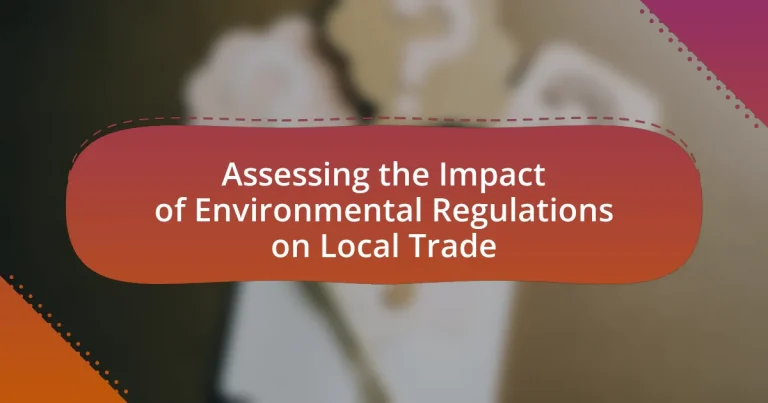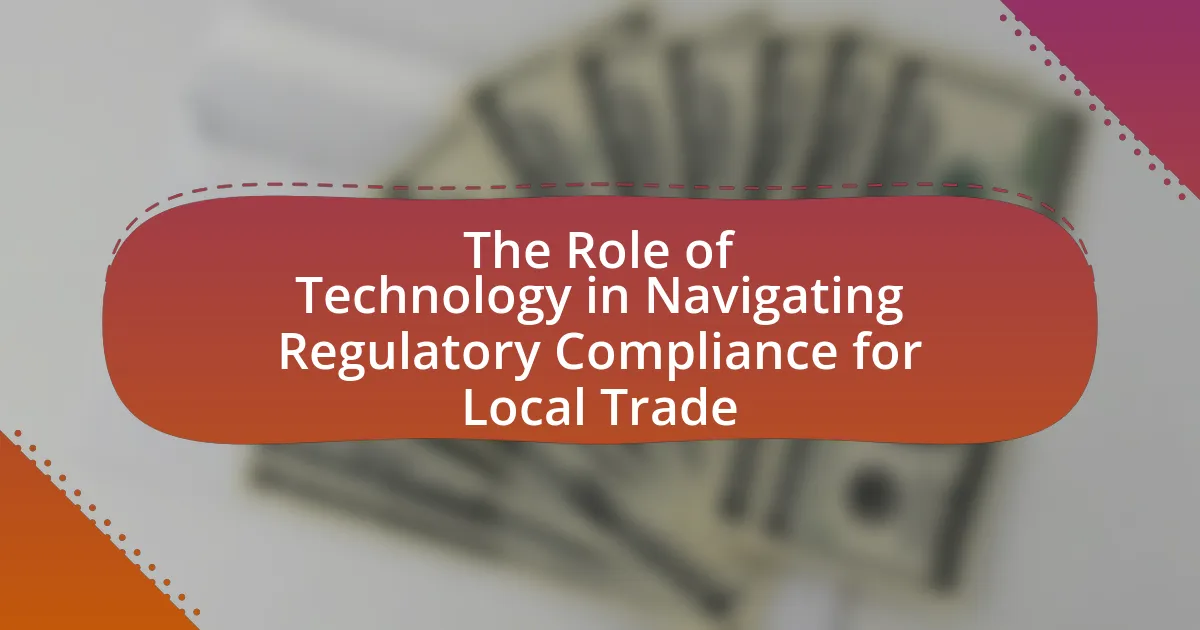Environmental regulations are laws and standards implemented by governments to protect the environment from harmful activities and pollutants, aiming to safeguard natural resources, public health, and ecosystems. This article assesses the impact of these regulations on local trade, highlighting their effects on local economies, business operations, and market dynamics. Key components of environmental regulations, such as air and water quality standards, waste management protocols, and guidelines for hazardous materials, are examined in relation to their influence on compliance costs, pricing strategies, and competition among businesses. The article also explores the economic implications for various sectors, including manufacturing and agriculture, and discusses strategies for businesses to adapt and thrive under these regulations while leveraging sustainability as a competitive advantage.
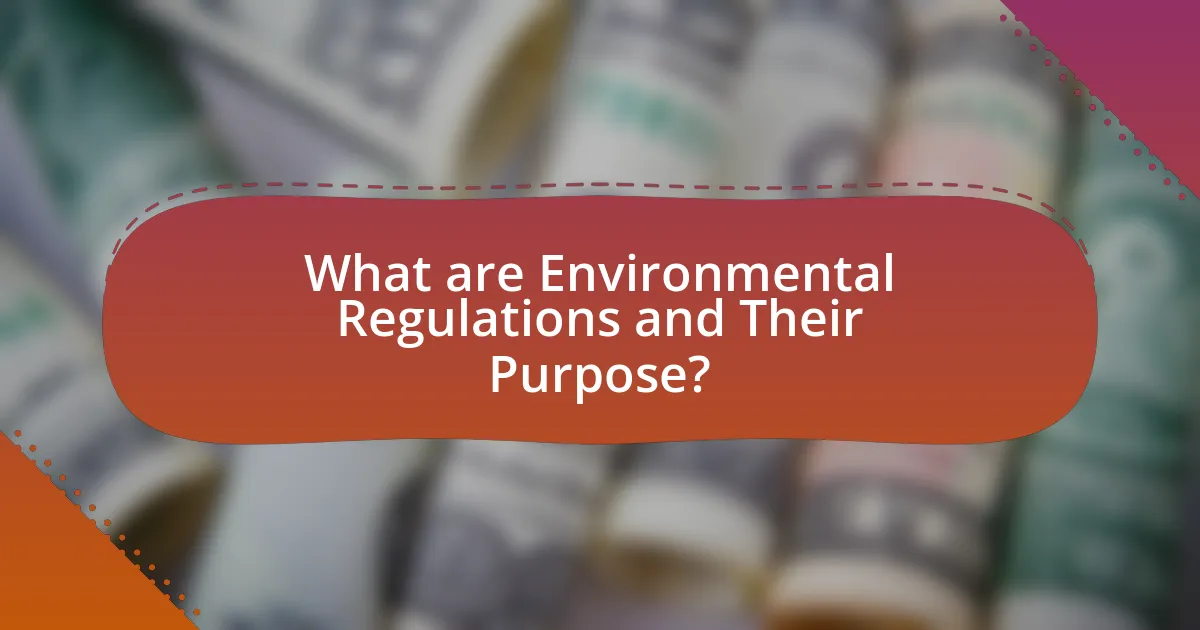
What are Environmental Regulations and Their Purpose?
Environmental regulations are laws and standards established by governments to protect the environment from harmful activities and pollutants. Their primary purpose is to safeguard natural resources, public health, and ecosystems by controlling emissions, waste disposal, and resource use. For instance, the Clean Air Act in the United States sets limits on air pollutants to improve air quality and protect human health, demonstrating the effectiveness of such regulations in achieving environmental goals.
How do Environmental Regulations affect local economies?
Environmental regulations can significantly impact local economies by influencing business operations, job creation, and investment patterns. These regulations often require businesses to adopt cleaner technologies and practices, which can lead to increased operational costs. For instance, a study by the National Bureau of Economic Research found that stringent environmental regulations can reduce employment in certain industries, particularly those heavily reliant on natural resources, by as much as 10% in some regions. Conversely, these regulations can also stimulate job growth in green technology sectors, creating new employment opportunities. Additionally, local economies may benefit from improved public health outcomes and environmental quality, which can enhance property values and attract new residents and businesses. Overall, the effects of environmental regulations on local economies are multifaceted, involving both challenges and opportunities for growth and sustainability.
What are the key components of Environmental Regulations?
The key components of Environmental Regulations include standards for air and water quality, waste management protocols, and guidelines for hazardous materials. These regulations are designed to protect public health and the environment by limiting pollution and ensuring sustainable resource use. For instance, the Clean Air Act establishes national air quality standards to reduce harmful emissions, while the Resource Conservation and Recovery Act governs the disposal of hazardous waste. These components are essential for compliance and enforcement, as they provide a framework for monitoring environmental impacts and promoting accountability among businesses and industries.
How do these components influence local trade practices?
Environmental regulations significantly influence local trade practices by imposing standards that businesses must meet to operate legally. These regulations often require companies to adopt sustainable practices, which can lead to increased operational costs and changes in supply chain management. For instance, a study by the World Bank found that stricter environmental regulations can lead to a 20% increase in compliance costs for small businesses, affecting their pricing strategies and competitiveness in local markets. Additionally, these regulations can create opportunities for businesses that specialize in eco-friendly products, thereby shifting local trade dynamics towards sustainability-focused practices.
Why are Environmental Regulations important for sustainability?
Environmental regulations are crucial for sustainability because they establish standards that protect natural resources and ecosystems from degradation. These regulations help to mitigate pollution, conserve biodiversity, and promote responsible resource management, which are essential for maintaining ecological balance. For instance, the Clean Air Act in the United States has significantly reduced air pollutants, leading to improved public health and environmental quality. Studies indicate that areas with stringent environmental regulations experience better long-term economic growth, as sustainable practices can lead to innovation and efficiency in local trade.
What role do Environmental Regulations play in protecting natural resources?
Environmental regulations play a crucial role in protecting natural resources by establishing legal frameworks that limit pollution, conserve biodiversity, and promote sustainable resource management. These regulations ensure that industries adhere to standards that minimize environmental degradation, thereby safeguarding ecosystems and the services they provide. For instance, the Clean Water Act in the United States regulates discharges of pollutants into water bodies, which helps maintain water quality and protect aquatic habitats. Additionally, the Endangered Species Act protects threatened and endangered species and their habitats, contributing to biodiversity conservation. Such regulations are essential for maintaining the balance of natural ecosystems, which in turn supports local economies that rely on these resources.
How do these regulations impact public health and safety?
Environmental regulations significantly enhance public health and safety by reducing exposure to harmful pollutants. For instance, regulations that limit emissions from industrial sources have been shown to decrease respiratory diseases and improve air quality. A study by the Environmental Protection Agency found that the Clean Air Act has prevented over 200,000 premature deaths annually by regulating air pollutants such as sulfur dioxide and nitrogen oxides. These regulations not only protect individual health but also contribute to broader community well-being by fostering safer environments.
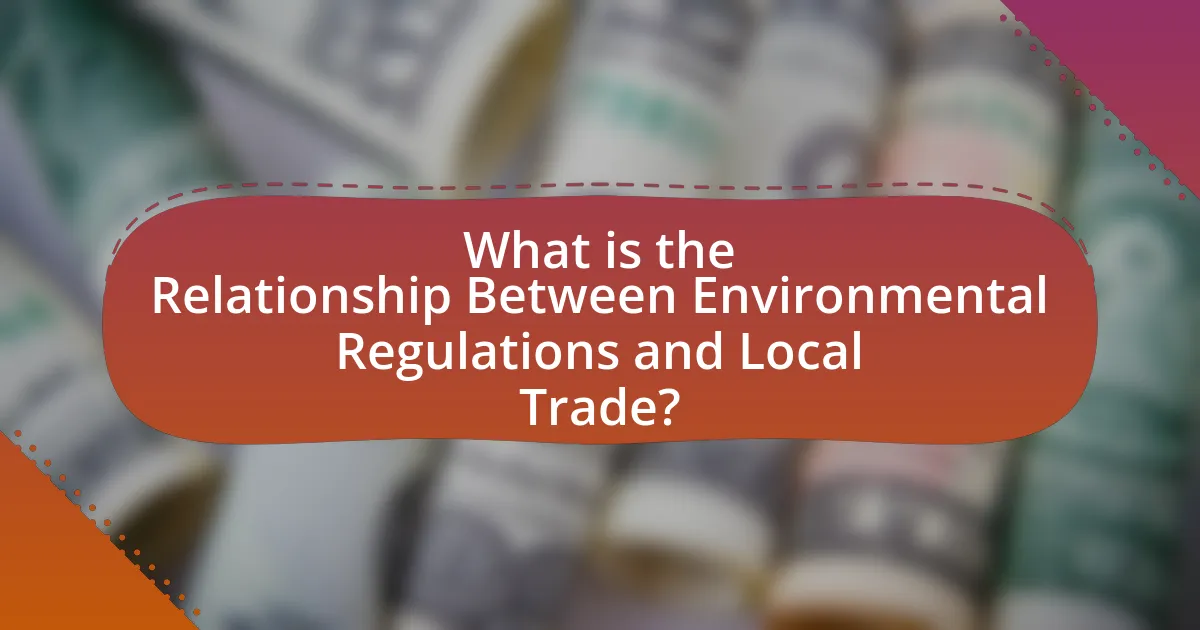
What is the Relationship Between Environmental Regulations and Local Trade?
Environmental regulations can significantly impact local trade by influencing operational costs and market access for businesses. Stricter regulations often lead to increased compliance costs for local businesses, which can reduce their competitiveness in both local and broader markets. For instance, a study by the National Bureau of Economic Research found that regions with stringent environmental regulations experienced a decline in manufacturing activity, as companies relocated to areas with less stringent rules, thereby affecting local trade dynamics. Additionally, while some businesses may face challenges, others may benefit from new market opportunities in green technologies and sustainable practices, indicating a complex relationship between environmental regulations and local trade.
How do Environmental Regulations influence local businesses?
Environmental regulations significantly influence local businesses by imposing compliance costs and operational changes. These regulations often require businesses to invest in cleaner technologies and sustainable practices, which can lead to increased operational expenses. For instance, a study by the National Bureau of Economic Research found that stricter environmental regulations can raise production costs by 3% to 5% for small businesses. Additionally, compliance with these regulations can create barriers to entry for new firms, as they may lack the resources to meet the required standards. However, these regulations can also drive innovation, as businesses seek to develop more efficient processes and products, ultimately benefiting the local economy in the long term.
What challenges do local businesses face due to these regulations?
Local businesses face significant challenges due to environmental regulations, primarily in the form of increased compliance costs. These costs arise from the need to invest in new technologies and processes to meet regulatory standards, which can strain financial resources, especially for small enterprises. For instance, a study by the National Federation of Independent Business found that 30% of small businesses reported that regulatory compliance costs were a major barrier to growth. Additionally, local businesses may experience operational disruptions as they adapt to new regulations, leading to reduced productivity and potential loss of customers. These challenges can hinder competitiveness and limit the ability of local businesses to thrive in a regulated market.
How can businesses adapt to comply with Environmental Regulations?
Businesses can adapt to comply with environmental regulations by implementing sustainable practices and technologies. This includes conducting regular environmental audits to assess compliance, investing in cleaner production methods, and training employees on environmental policies. For instance, a study by the World Bank found that companies adopting eco-friendly technologies can reduce operational costs by up to 30%, demonstrating that compliance can also lead to financial benefits. Additionally, businesses can engage with stakeholders and regulatory bodies to stay informed about changes in legislation, ensuring proactive compliance.
What are the economic impacts of Environmental Regulations on local trade?
Environmental regulations can lead to both positive and negative economic impacts on local trade. On one hand, these regulations can increase operational costs for businesses due to compliance requirements, which may reduce profit margins and competitiveness in local markets. For example, a study by the National Bureau of Economic Research found that stringent environmental regulations can lead to a 10% increase in production costs for small manufacturers. On the other hand, environmental regulations can stimulate local trade by fostering innovation and creating new markets for green technologies and sustainable products. The U.S. Environmental Protection Agency reported that investments in clean technology can generate significant economic growth, with the clean energy sector projected to create millions of jobs. Thus, while environmental regulations may impose short-term costs, they can also drive long-term economic benefits through innovation and new market opportunities.
How do these regulations affect pricing and competition among local businesses?
Environmental regulations typically increase operational costs for local businesses, which can lead to higher pricing for consumers. When businesses are required to invest in cleaner technologies or comply with stricter standards, these costs are often passed on to customers in the form of increased prices. For example, a study by the National Bureau of Economic Research found that compliance with environmental regulations can raise production costs by 5% to 10%, directly impacting pricing strategies.
Moreover, these regulations can alter competition among local businesses. Smaller firms may struggle to meet compliance costs compared to larger corporations with more resources, potentially leading to reduced competition in the market. A report from the Environmental Protection Agency indicates that while regulations can drive innovation, they may also result in market consolidation as smaller businesses exit the market due to financial strain. Thus, environmental regulations can create a dual effect: raising prices for consumers while reshaping the competitive landscape among local businesses.
What are the long-term economic benefits of adhering to Environmental Regulations?
Adhering to environmental regulations yields long-term economic benefits such as increased efficiency, reduced health costs, and enhanced competitiveness. Companies that comply with these regulations often invest in cleaner technologies, leading to operational efficiencies that lower production costs over time. For instance, a study by the World Bank found that businesses adopting sustainable practices can reduce energy consumption by up to 30%, translating into significant cost savings. Additionally, adhering to environmental standards can lead to improved public health outcomes, which in turn reduces healthcare costs for governments and communities. The American Public Health Association reported that cleaner air and water can save billions in healthcare expenses annually. Furthermore, businesses that prioritize sustainability often gain a competitive edge in the market, as consumers increasingly prefer environmentally responsible products. This shift can lead to increased market share and profitability in the long run.
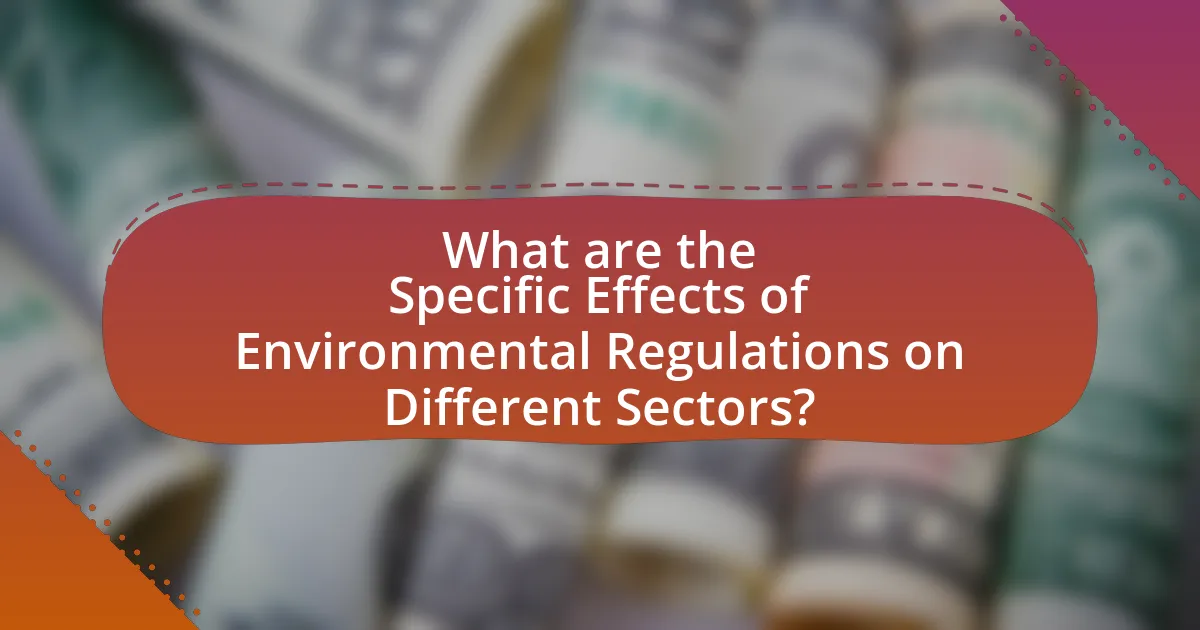
What are the Specific Effects of Environmental Regulations on Different Sectors?
Environmental regulations have specific effects on various sectors, influencing operational costs, compliance requirements, and market competitiveness. In the manufacturing sector, for instance, stricter emissions standards often lead to increased production costs due to the need for advanced technologies and processes to meet compliance. According to a study by the National Bureau of Economic Research, firms that adopted cleaner technologies experienced a 10% increase in operational costs but also gained a competitive edge in environmentally conscious markets.
In the agriculture sector, regulations aimed at reducing pesticide use can lead to higher production costs and shifts in crop selection, as farmers may need to invest in organic practices or alternative pest management strategies. Research from the Environmental Protection Agency indicates that such regulations can reduce pesticide-related health risks but may also decrease short-term yields.
The energy sector faces significant impacts from environmental regulations, particularly those targeting carbon emissions. The transition to renewable energy sources, driven by regulatory frameworks, has resulted in substantial investments in solar and wind technologies. A report by the International Renewable Energy Agency highlights that countries implementing stringent carbon regulations have seen a 20% increase in renewable energy capacity over the past decade.
In the transportation sector, regulations aimed at reducing fuel emissions have prompted manufacturers to innovate, leading to the development of electric and hybrid vehicles. The U.S. Department of Energy reports that these regulations have spurred a 30% increase in electric vehicle sales since 2015.
Overall, environmental regulations shape sector-specific dynamics by altering cost structures, encouraging innovation, and influencing market trends, ultimately impacting local trade and economic performance.
How do Environmental Regulations impact the manufacturing sector?
Environmental regulations significantly impact the manufacturing sector by imposing compliance costs and operational changes. These regulations often require manufacturers to invest in cleaner technologies and processes, which can lead to increased production costs. For instance, a study by the National Association of Manufacturers found that regulatory compliance can cost manufacturers up to $19,564 per employee annually. Additionally, these regulations can drive innovation as companies seek to develop more efficient and sustainable practices, potentially leading to competitive advantages in the market. However, stringent regulations may also result in reduced competitiveness for smaller manufacturers who may lack the resources to comply effectively.
What specific regulations affect manufacturing processes?
Specific regulations that affect manufacturing processes include the Clean Air Act, the Clean Water Act, and the Resource Conservation and Recovery Act. The Clean Air Act regulates air emissions from stationary and mobile sources, requiring manufacturers to comply with national air quality standards. The Clean Water Act governs discharges of pollutants into U.S. waters, mandating permits for wastewater discharges and setting water quality standards. The Resource Conservation and Recovery Act oversees the management of hazardous waste, ensuring that manufacturers handle waste safely and sustainably. These regulations are designed to protect environmental quality and public health, influencing manufacturing practices and operational costs.
How do manufacturers balance compliance with profitability?
Manufacturers balance compliance with profitability by integrating sustainable practices that meet regulatory requirements while optimizing operational efficiency. This approach often involves investing in cleaner technologies and processes that reduce waste and energy consumption, which can lead to cost savings over time. For instance, a study by the World Economic Forum found that companies adopting sustainable practices can experience a 20% reduction in operational costs. By aligning compliance with profitability, manufacturers not only adhere to environmental regulations but also enhance their market competitiveness and brand reputation.
What is the effect of Environmental Regulations on the agricultural sector?
Environmental regulations significantly impact the agricultural sector by imposing standards that farmers must meet to minimize environmental harm. These regulations can lead to increased operational costs due to the need for compliance with practices such as sustainable farming, waste management, and pesticide use restrictions. For instance, a study by the Environmental Protection Agency indicates that compliance costs can range from 1% to 5% of total agricultural revenue, affecting profit margins. Additionally, while these regulations aim to protect ecosystems and public health, they can also incentivize innovation in sustainable practices, ultimately benefiting the sector in the long term.
How do these regulations influence farming practices?
Environmental regulations significantly influence farming practices by mandating sustainable methods that reduce pollution and conserve resources. These regulations often require farmers to adopt practices such as crop rotation, integrated pest management, and reduced chemical usage, which can lead to improved soil health and biodiversity. For instance, the Clean Water Act in the United States enforces standards that limit runoff from agricultural operations, compelling farmers to implement buffer zones and cover crops to protect water quality. Studies have shown that compliance with such regulations can enhance long-term productivity and profitability by fostering healthier ecosystems, thereby validating the positive impact of these regulations on farming practices.
What are the economic implications for local farmers?
The economic implications for local farmers include increased operational costs and potential market access challenges due to environmental regulations. These regulations often require farmers to invest in sustainable practices and technologies, which can lead to higher production costs. For instance, a study by the Environmental Protection Agency indicates that compliance with regulations can increase costs by 10-30% for small to medium-sized farms. Additionally, stricter regulations may limit the types of crops that can be grown or the methods used, potentially reducing yield and profitability. Consequently, local farmers may face decreased competitiveness in both local and broader markets, impacting their overall economic viability.
What strategies can local businesses implement to thrive under Environmental Regulations?
Local businesses can thrive under environmental regulations by adopting sustainable practices, enhancing operational efficiency, and engaging in community partnerships. Implementing energy-efficient technologies reduces operational costs and aligns with regulatory standards, as evidenced by a study from the U.S. Department of Energy, which found that businesses adopting energy efficiency measures can save up to 30% on energy bills. Additionally, local businesses can invest in waste reduction strategies, such as recycling and composting, which not only comply with regulations but also appeal to environmentally conscious consumers. Collaborating with local governments and organizations can provide access to resources and incentives, further supporting compliance and innovation. These strategies collectively enable local businesses to not only meet regulatory requirements but also enhance their market competitiveness and community reputation.
How can businesses leverage sustainability as a competitive advantage?
Businesses can leverage sustainability as a competitive advantage by integrating eco-friendly practices into their operations, which can enhance brand loyalty and attract environmentally conscious consumers. For instance, companies that adopt sustainable sourcing and reduce waste often see increased customer engagement, as 66% of consumers are willing to pay more for sustainable brands, according to a Nielsen report. Additionally, sustainable practices can lead to cost savings through energy efficiency and waste reduction, further improving profitability. By positioning themselves as leaders in sustainability, businesses can differentiate themselves in the market, ultimately driving growth and enhancing their reputation.
What best practices should businesses adopt for compliance and growth?
Businesses should adopt a proactive compliance strategy and integrate sustainability into their growth plans. Proactive compliance involves regularly updating policies to align with environmental regulations, which can mitigate legal risks and enhance reputation. For instance, companies that implement comprehensive environmental management systems often see a reduction in compliance costs by up to 30%, as reported by the International Organization for Standardization. Additionally, integrating sustainability into business operations can lead to innovation and new market opportunities, as evidenced by a McKinsey report indicating that companies with strong sustainability practices outperform their peers in financial performance.
